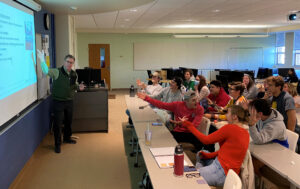 Delivering the best lecture ever, obviously.
Delivering the best lecture ever, obviously.
Teaching is both an art and a science.
The art of teaching involves “reading” students—understanding their abilities and limitations—and learning to address their specific methods of learning. Each student and class is unique, and what works for one class may not work as well for the next. A teacher looking for the best results must be flexible in approach while maintaining high expectations.
Teaching also is a science—an activity that can be methodically analyzed and improved. According to Ken Bain, the director of the Center for Teaching Excellence at New York University, the best college teachers understand that:
- Knowledge is constructed, not received
- Mental models change slowly
- Questions are crucial
- Caring is crucial
When a teacher conceives of education as constructing knowledge, not simply delivering content, the opportunities for innovative teaching are manifold.
While innovation is important, addressing perennial concerns is important, as well. In his review of American universities, Derek Bok identifies eight purposes of a university. The first purpose Bok lists is “learning to communicate,” which he subdivides into “learning to write” and “oral communication,” with an emphasis on the former.
With a master’s degree in English and experience teaching technical writing and English composition, I look for appropriate opportunities within my courses for students to improve their writing skills.
Bain, Ken. What the Best College Teachers Do. 2004.
Bok, Derek. Our Underachieving Colleges: A Candid Look at How Much Students Learn and Why They Should Be Learning More. 2006.
 ARCH 362 Light Fixtures, designed and built by students.
ARCH 362 Light Fixtures, designed and built by students.